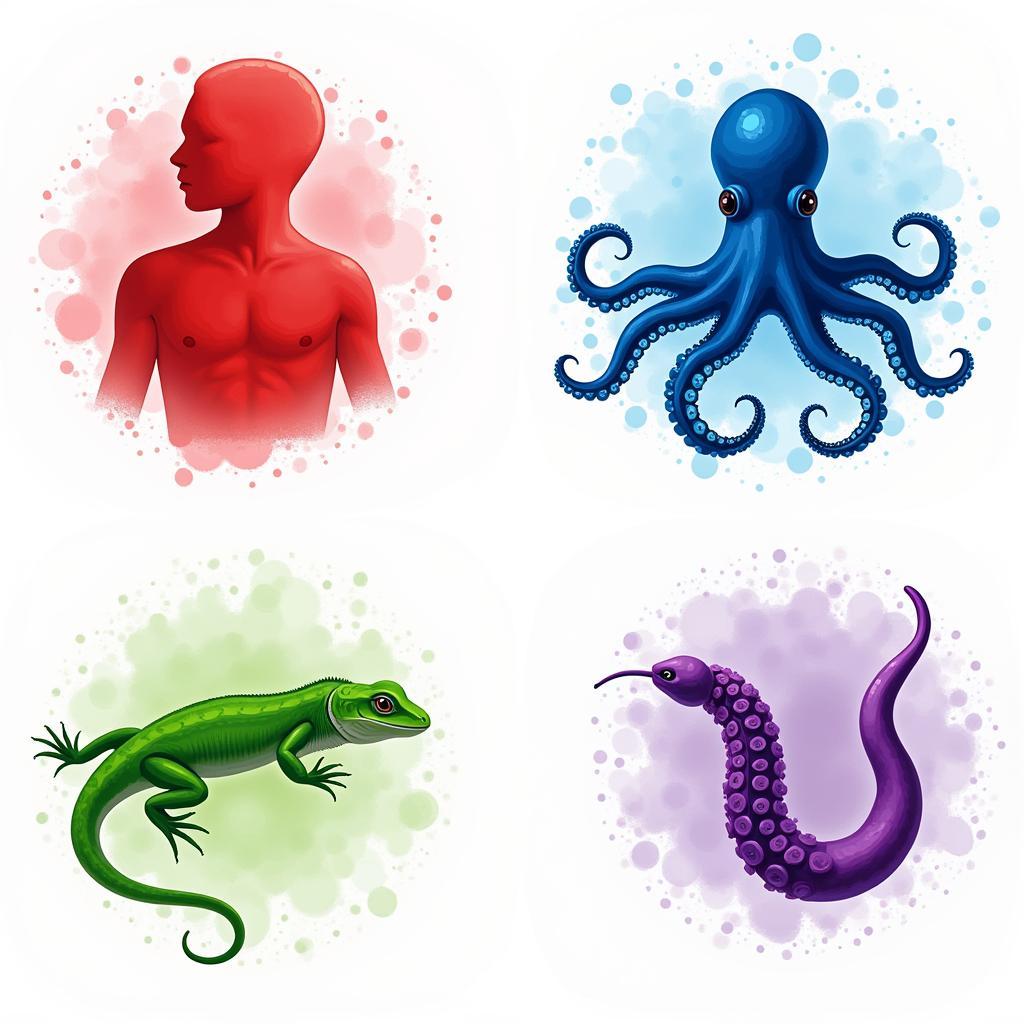Blood, the vital fluid that sustains life, is often associated with the vibrant red hue we’re familiar with. But what color is blood, truly? The answer, surprisingly, isn’t always red. While human blood owes its crimson color to hemoglobin, other creatures in the animal kingdom boast blood of varying hues, from blue to green, and even violet. This fascinating diversity reflects the different ways organisms have adapted to their environments and the unique molecules they use to transport oxygen. Understanding “de q color es la sangre” (what color is blood) opens a window into the incredible biodiversity of our planet.
The familiar red color of human blood is due to the iron-containing protein hemoglobin. Hemoglobin binds to oxygen in the lungs and carries it throughout the body, delivering this essential element to cells and tissues. This interaction with oxygen gives blood its characteristic red color. However, this isn’t the only way organisms transport oxygen. Different species have evolved unique mechanisms and molecules to carry out this vital function, resulting in a surprising variety of blood colors. For example, some creatures use hemocyanin, a copper-containing protein that gives their blood a blue tint when oxygenated. This explains why the blood of some invertebrates, like octopuses and horseshoe crabs, appears blue.
Exploring the Colorful Spectrum of Blood
From the deep blue of the octopus to the vibrant green of some lizards, the diversity of blood color in the animal kingdom is truly astonishing. This variation stems from the different respiratory pigments organisms utilize. Let’s dive into some examples:
- Blue Blood: Invertebrates like octopuses, spiders, and horseshoe crabs utilize hemocyanin, a copper-containing protein, to transport oxygen. Hemocyanin turns blue when oxygenated, giving their blood its distinctive color.
- Green Blood: Certain lizards of the New Guinea skink family have green blood. This unusual coloration is caused by high levels of biliverdin, a green bile pigment, which overwhelms the red color of hemoglobin.
- Violet Blood: Some marine worms possess hemerythrin, an iron-containing protein that gives their blood a violet or pink hue.
- Colorless Blood: Several species of icefish living in the Antarctic Ocean have colorless blood. These fish lack hemoglobin, relying on the high oxygen content of the frigid waters to diffuse directly into their blood.
 Diverse Blood Colors in the Animal Kingdom
Diverse Blood Colors in the Animal Kingdom
What Color Blood Do Octopus Have? A Deep Dive into Blue Blood
Octopuses, fascinating creatures of the deep, are known for their intelligence and remarkable camouflage abilities. But they also harbor a secret within their veins: blue blood. As mentioned earlier, this unique color is due to hemocyanin, the copper-containing protein that carries oxygen in their blood. This adaptation allows them to thrive in oxygen-poor environments, like the deep ocean floor. You can find more information on octopus blood at de que color es la sangre del pulpo. Similarly, horseshoe crabs also have blue blood due to hemocyanin.
Why is Blue Blood Important?
The blue blood of horseshoe crabs plays a crucial role in biomedical research. Their blood contains a special clotting agent called Limulus amebocyte lysate (LAL), which is used to detect bacterial contamination in pharmaceuticals and medical devices. This unique property makes horseshoe crab blood incredibly valuable to the medical industry. You can learn more about interesting facts like does colorado have earthquakes on our site.
The Significance of Understanding Blood Color
The question “de q color es la sangre” goes beyond mere curiosity. It highlights the incredible adaptability and diversity of life on Earth. Studying the different blood pigments and their functions provides valuable insights into the evolutionary history and physiological adaptations of various species. This knowledge can also have practical applications, as seen in the use of horseshoe crab blood in the medical field. For those interested in summer destinations, check out where to go in colorado in summer.
How Does Blood Color Relate to Habitat?
Blood color can often be linked to an organism’s environment. For example, the blue blood of octopuses, which allows them to thrive in low-oxygen environments, is a testament to the power of adaptation. Similarly, the colorless blood of icefish is a perfect adaptation to the oxygen-rich, frigid waters of the Antarctic. Learn more about Colorado geography with this article on where is custer county colorado. This further emphasizes how closely interconnected life and environment are. More information about octopus blood color can be found here: what color blood do octopus have.
In conclusion, the question “de q color es la sangre” reveals a fascinating world of biological diversity. From the common red of human blood to the unusual blue of octopuses, blood color tells a story of adaptation and survival. Understanding these variations deepens our appreciation for the intricate workings of life on our planet.
FAQ:
- What gives human blood its red color? Hemoglobin.
- What color is octopus blood? Blue.
- Why do some lizards have green blood? High levels of biliverdin.
- What is the function of hemocyanin? Oxygen transport.
- What is LAL and why is it important? Limulus amebocyte lysate, used to detect bacterial contamination.
- What is unique about icefish blood? It is colorless and lacks hemoglobin.
- Why is understanding blood color important? It reveals biological diversity and adaptation.
Need help with color selection for your next project? Contact us at: Phone: 0373298888, Email: [email protected] or visit us at 86 Cau Giay, Hanoi. We have a 24/7 customer service team.

